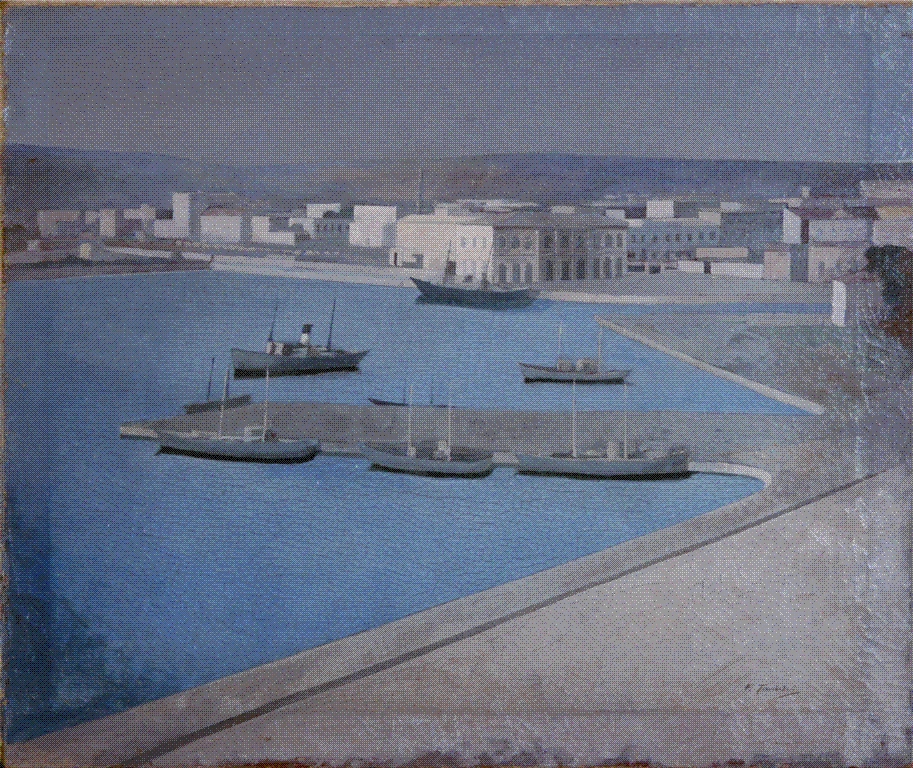TROMBADORI FRANCESCO
(Siracusa 1886 – Roma 1961). Artista mediterranea di forte valenza poetica, allievo del Cellini, frequenta la bottega d’arte del pittore Enrico Lionne, nel 1916 si sposa ed ha due figli, in questo periodo la sua pittura è influenzata dal “Divisionismo” e dal “Puntinismo”, portandolo a dipingere “Siracusa mia” il suo capolavoro.Nei primi anni ’20, stringe amicizia con Elio Vittorini, Vincenzo Caldarelli, e Renato Guttuso; nel 1921 è nominato professore di disegno all’ITI di Civitavecchia, fa il pendolare per lungo tempo ed è per questo che forse le sue opere vengono caratterizzate spesso da soggetti come binari e stazioni. Con il “Ritratto di signorina” e poi “Autoritratto” nel 1932 esprime la sua arte in pieno stile purista. Nel 1942 disapprovando gli orrori del regime fascista, la sua pittura subisce un’altra trasformazione, dipinge Roma inondata di luce astratta, quasi lunare. Nel 1950 torna a Siracusa due volte l’anno, ci torna anche due mesi prima di morire. Tiene diverse personali. Trombadori è un amante della zona di Siracura, una persona molto riservata, nel periodo givanile firmava i quadri con il nome d’arte Franz D’Ortigia. Nella sua pittura l’artista ha portato quanto non aveva potuto esprimere in passato sulla sua città, cioè la luce. Egli nei suoi dipinti raffigura frutti, pesci e volatili, presentandoli con gioia agli occhi di chi li osserva. La compostezza della sua pittura ha un timbro particolare, tipico del temperamento siciliano.
 MARINA DI SIRACUSA
MARINA DI SIRACUSA
1953 - olio su tela, cm 48x58
Con questo dipinto Trombadori nel 1953 vinse in ex-aequo con Daniele Schmiedt il Premio “Antonello”, dedicato al tema del paesaggio siciliano, nell’ambito della seconda ed ultima edizione della “Mostra Internazionale di Pittura Città di Messina”. Il dipinto appartiene all’ultima fase del percorso multiforme ma limpido e coerente dell’autore (derivante dalle esperienze del Divisionismo e del Neoclassicismo), quando si intensificano i suoi ritorni in Sicilia, nella sua amata Ortigia, raffigurata più volte in altre tele degli anni ’50 quali: “Marina di Siracusa”, “Passaggio a Livello” e “Porto di Siracusa”. Schede Catalogo
 Francesco Trombadori - Was born in Syracuse on the 1886 and was died in Rome on the 1961. Mediterranean artist of great poetic value, a pupil of Cellini, he attended the art studio of the painter Enrico Lionne, in 1916 he married and has two children. During this period his painting is influenced by the “Divisionism” an “Pointillism” leading him to paint “My Syracuse” his masterpiece. In the early ’20th he became friends with Elio Vittorini, Vincenzo Caldarelli and Renato Guttuso. In 1921 he was appointed Professor of Industrial Designer at the Technical Institute of Civitavecchia. Committes for a long time, it is probably foe this reason that his works are often characterized by subjects such as tracks and stations. With the “Portait of Miss” and then “Self Portrait” in 1932 expresses his art style purist. In 1942, disapproving the horrors of the fascist regime, his painting undergoes another transformation, paints Rome flooded with light abstract almost lunar. In 1950 returns two months before he died. Trombadori is a lover of the Syracuse area, ia a very private person, and during his youth he sign his paintings, whit the stage name of Franz D’Ortigia. In his painting, the artist has brought what he could not express in the past about his city, that his the light and what he had done during his stay on the island. He in his paintings depicting fruits, fish and poultry, presenting them with jay in the eyes of the beholder. The composure of his painting has a particular stamp, typical of Sicilian temperament.
Francesco Trombadori - Was born in Syracuse on the 1886 and was died in Rome on the 1961. Mediterranean artist of great poetic value, a pupil of Cellini, he attended the art studio of the painter Enrico Lionne, in 1916 he married and has two children. During this period his painting is influenced by the “Divisionism” an “Pointillism” leading him to paint “My Syracuse” his masterpiece. In the early ’20th he became friends with Elio Vittorini, Vincenzo Caldarelli and Renato Guttuso. In 1921 he was appointed Professor of Industrial Designer at the Technical Institute of Civitavecchia. Committes for a long time, it is probably foe this reason that his works are often characterized by subjects such as tracks and stations. With the “Portait of Miss” and then “Self Portrait” in 1932 expresses his art style purist. In 1942, disapproving the horrors of the fascist regime, his painting undergoes another transformation, paints Rome flooded with light abstract almost lunar. In 1950 returns two months before he died. Trombadori is a lover of the Syracuse area, ia a very private person, and during his youth he sign his paintings, whit the stage name of Franz D’Ortigia. In his painting, the artist has brought what he could not express in the past about his city, that his the light and what he had done during his stay on the island. He in his paintings depicting fruits, fish and poultry, presenting them with jay in the eyes of the beholder. The composure of his painting has a particular stamp, typical of Sicilian temperament.
MARINE SYRACUSE - 1953 - olio su tela, cm 48x58 - It's an oil on canvas. With this painting Trombadori won in 1953 in a tie with Daniel Schmiedt the “Prize Antonello”, dedicated to the theme of the Sicilianlandscape, in the second and final edition of the “International Exhibition of Painting the City of Messina”. The painting belongs to the last step of the way but multifaceted clear coherent author (deriving from the experiences of the so-called Pointillism and neoclassicism) when the intensification of his return to Sicily, in his beloved Ortigia, depicted several times in other paintings of the years 50 such as: Marina di Siracusa, Level Crossing and Port of Syracuse.